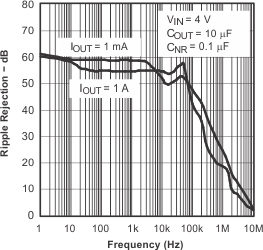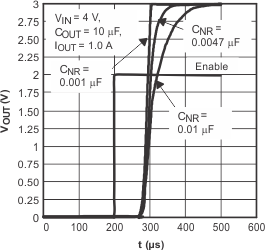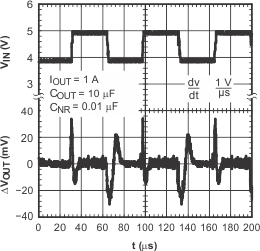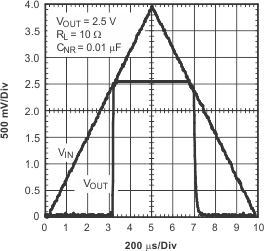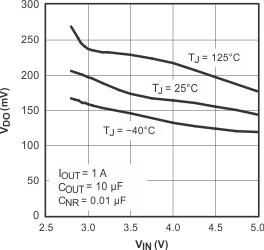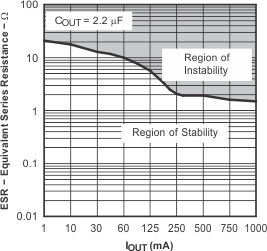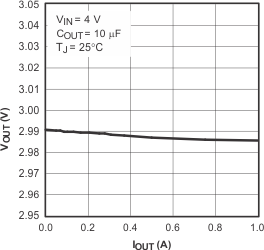SLVS351P September 2002 – March 2015
PRODUCTION DATA.
- 1 Features
- 2 Applications
- 3 Description
- 4 Revision History
- 5 Pin Configuration and Functions
- 6 Specifications
- 7 Detailed Description
- 8 Application and Implementation
- 9 Power Supply Recommendations
- 10Layout
- 11Device and Documentation Support
- 12Mechanical, Packaging, and Orderable Information
封装选项
机械数据 (封装 | 引脚)
散热焊盘机械数据 (封装 | 引脚)
订购信息
6 Specifications
6.1 Absolute Maximum Ratings
over operating junction temperature range (unless otherwise noted) (1)| MIN | MAX | UNIT | ||
|---|---|---|---|---|
| Voltage | IN | –0.3 | 6 | V |
| EN | –0.3 | VIN + 0.3 | ||
| OUT | 6 | |||
| Current | Peak output | Internally limited | ||
| Power dissipation | Continuous total | See Thermal Information | ||
| Temperature | Junction, TJ | –40 | 150 | °C |
| Storage, Tstg | –65 | 150 | ||
(1) Stresses beyond those listed under Absolute Maximum Ratings may cause permanent damage to the device. These are stress ratings only, which do not imply functional operation of the device at these or any other conditions beyond those indicated under Recommended Operating Conditions. Exposure to absolute-maximum-rated conditions for extended periods may affect device reliability.
6.2 ESD Ratings
| VALUE | UNIT | |||
|---|---|---|---|---|
| V(ESD) | Electrostatic discharge | Human body model (HBM), per ANSI/ESDA/JEDEC JS-001, all pins(1) | ±2000 | V |
| Charged device model (CDM), per JEDEC specification JESD22-C101, all pins(2) | ±500 | |||
(1) JEDEC document JEP155 states that 500-V HBM allows safe manufacturing with a standard ESD control process.
(2) JEDEC document JEP157 states that 250-V CDM allows safe manufacturing with a standard ESD control process.
6.3 Recommended Operating Conditions
over operating junction temperature range (unless otherwise noted)| MIN | NOM | MAX | UNIT | ||
|---|---|---|---|---|---|
| VIN | Input voltage | 2.7 | 5.5 | V | |
| IOUT | Output current | 0 | 1 | A | |
| TJ | Operating junction temperature | –40 | 125 | °C | |
6.4 Thermal Information
| THERMAL METRIC(1)(2) | TPS796xx(3) | UNIT | |||
|---|---|---|---|---|---|
| DRB (VSON) | DCQ (SOT-223) |
KTT (TO-263) | |||
| 8 PINS | 6 PINS | 5 PINS | |||
| RθJA | Junction-to-ambient thermal resistance | 47.8 | 70.4 | 25 | °C/W |
| RθJC(top) | Junction-to-case (top) thermal resistance | 83 | 70 | 35 | |
| RθJB | Junction-to-board thermal resistance | N/A | N/A | N/A | |
| ψJT | Junction-to-top characterization parameter | 2.1 | 6.8 | 1.5 | |
| ψJB | Junction-to-board characterization parameter | 17.8 | 30.1 | 8.52 | |
| RθJC(bot) | Junction-to-case (bottom) thermal resistance | 12.1 | 6.3 | 0.4 | |
(1) For more information about traditional and new thermal metrics, see the IC Package Thermal Metrics application report, SPRA953.
(2) For thermal estimates of this device based on PCB copper area, see the TI PCB Thermal Calculator.
(3) Thermal data for the DRB, DCQ, and DRV packages are derived by thermal simulations based on JEDEC-standard methodology as specified in the JESD51 series. The following assumptions are used in the simulations:
-
i. DRB: The exposed pad is connected to the PCB ground layer through a 2 × 2 thermal via array.
ii. DCQ: The exposed pad is connected to the PCB ground layer through a 3 × 2 thermal via array.
iii. KTT: The exposed pad is connected to the PCB ground layer through a 5 × 4 thermal via array. -
i. DRB: The top and bottom copper layers are assumed to have a 20% thermal conductivity of copper representing a 20% copper coverage.
ii. DCQ: Each of top and bottom copper layers has a dedicated pattern for 20% copper coverage.
iii. KTT: The top and bottom copper layers are assumed to have a 20% thermal conductivity of copper representing a 20% copper coverage. - These data were generated with only a single device at the center of a JEDEC high-K (2s2p) board with 3in × 3in copper area. To understand the effects of the copper area on thermal performance, see Power Dissipation and Estimating Junction Temperature.
6.5 Electrical Characteristics
Over recommended operating temperature range (TJ = –40°C to 125°C), VEN = VIN,, VIN = VOUT(nom) + 1 V(1), IOUT = 1 mA, COUT = 10 μF, and CNR = 0.01 μF, unless otherwise noted. Typical values are at 25°C.| PARAMETER | TEST CONDITIONS | MIN | TYP | MAX | UNIT | |||
|---|---|---|---|---|---|---|---|---|
| VIN | Input voltage(1) | 2.7 | 5.5 | V | ||||
| VFB | Internal reference (TPS79601) | 1.2 | 1.225 | 1.25 | V | |||
| IOUT | Continuous output current | 0 | 1 | A | ||||
| VOUT | Output voltage range | TPS79601 | 1.225 | 5.5 – VDO | V | |||
| Accuracy | TPS79601(2) | 0 μA ≤ IOUT ≤ 1 A, VOUT(nom) + 1 V ≤ VIN ≤ 5.5 V(1) | 0.98VOUT(nom) | VOUT(nom) | 1.02VOUT(nom) | V | ||
| Fixed VOUT < 5 V | 0 μA ≤ IOUT ≤ 1 A, VOUT(nom) + 1 V ≤ VIN ≤ 5.5 V(1) | –2% | 2% | |||||
| Fixed VOUT = 5 V | 0 μA ≤ IOUT ≤ 1 A, VOUT(nom) + 1 V ≤ VIN ≤ 5.5 V(1) | –3% | 3% | |||||
| ΔVO(ΔVI) | Line regulation(1) | VOUT + 1 V ≤ VIN ≤ 5.5 V | 0.05 | 0.12 | %/V | |||
| ΔVO(ΔIO) | Load regulation | 0 μA ≤ IOUT ≤ 1 A | 5 | mV | ||||
| VDO | Dropout voltage(3)
(VIN = VOUT(nom) – 0.1 V) |
TPS79628 | IOUT = 1 A | 270 | 365 | mV | ||
| TPS79628DRB | IOUT = 250 mA | 52 | 90 | |||||
| TPS79630 | IOUT = 1 A | 250 | 345 | |||||
| TPS79633 | IOUT = 1 A | 220 | 325 | |||||
| TPS79650 | IOUT = 1 A | 200 | 300 | |||||
| ICL | Output current limit | VOUT = 0 V | 2.4 | 4.2 | A | |||
| IGND | Ground pin current | 0 μA ≤ IOUT ≤ 1 A | 265 | 385 | μA | |||
| ISHDN | Shutdown current(4) | VEN = 0 V, 2.7 V ≤ VIN ≤ 5.5 V | 0.07 | 1 | μA | |||
| IFB | Feedback pin current | VFB = 1.225 V | 1 | µA | ||||
| PSRR | Power-supply rejection ratio (TPS79630) | f = 100 Hz. IOUT = 10 mA | 59 | dB | ||||
| f = 100 Hz, IOUT = 1 A | 54 | |||||||
| f = 10 kHz, IOUT = 1A | 53 | |||||||
| f = 100 kHz, IOUT = 1 A | 42 | |||||||
| Vn | Output noise voltage (TPS79630) | BW = 100 Hz to 100 kHz, IOUT = 1 A | CNR = 0.001 μF | 54 | μVRMS | |||
| CNR = 0.0047 μF | 46 | |||||||
| CNR = 0.01 μF | 41 | |||||||
| CNR = 0.1 μF | 40 | |||||||
| Start-up time (TPS79630) | RL = 3 Ω, COUT = 1 μF |
CNR = 0.001 μF | 50 | μs | ||||
| CNR = 0.0047 μF | 75 | |||||||
| CNR = 0.01 μF | 110 | |||||||
| VEN(HI) | Enable high (enabled) | 2.7 V ≤ VIN ≤ 5.5 V | 1.7 | VIN | V | |||
| VEN(LO) | Enable low (shutdown) | 2.7 V ≤ VIN ≤ 5.5 V | 0 | 0.7 | V | |||
| IEN(HI) | Enable pin current, enabled | VEN = 0 V | –1 | 1 | μA | |||
| UVLO | Undervoltage lockout | VCC rising | 2.25 | 2.65 | V | |||
| Hysteresis | 100 | mV | ||||||
| Tsd | Thermal shutdown temperature | Shutdown, temperature increasing | 165 | °C | ||||
| Reset, temperature decreasing | 140 | |||||||
| TJ | Operating junction temperature | –40 | 125 | °C | ||||
(1) Minimum VIN = VOUT + VDO or 2.7 V, whichever is greater. TPS79650 is tested at VIN = 5.5 V.
(2) Tolerance of external resistors not included in this specification.
(3) VDO is not measured for TPS79618 and TPS79625 because minimum VIN = 2.7 V.
(4) For adjustable version, this applies only after VIN is applied; then VEN transitions high to low.
6.6 Typical Characteristics
At VEN = VIN, VIN = VOUT(nom) + 1 V, IOUT = 1 mA, COUT = 10 µF, CNR = 0.01 µF, CIN = 2.2 µF, and TJ = 25°C, unless otherwise noted.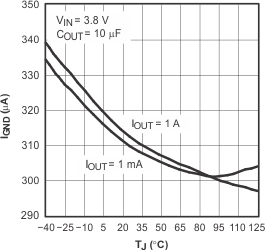
Junction Temperature
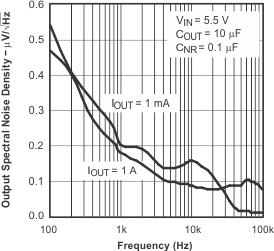
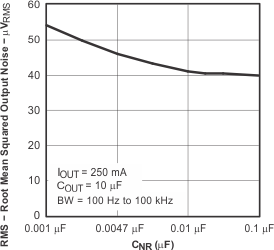
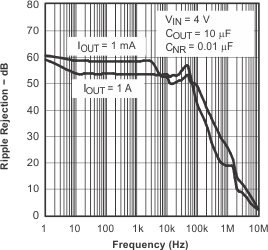
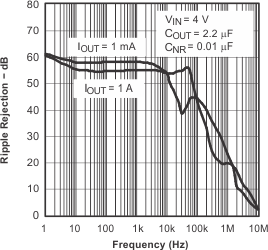
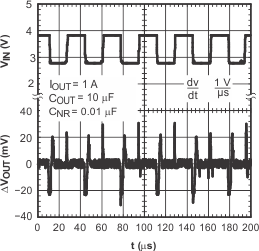
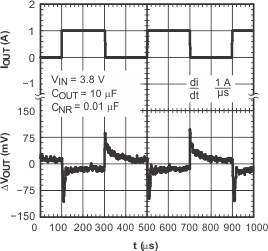
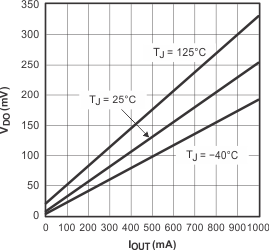
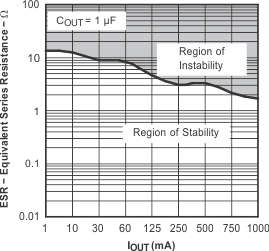
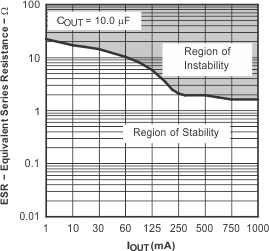
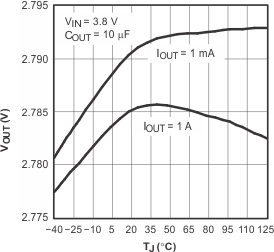
Junction Temperature
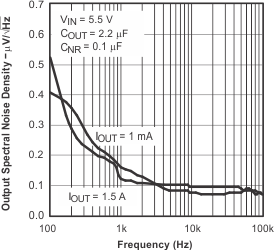
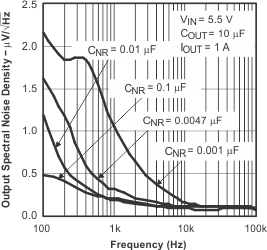
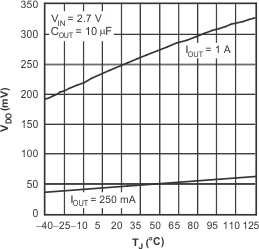
Junction Temperature
